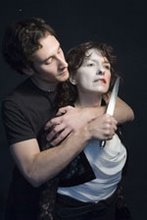"YOU LIVE BECAUSE INSECTS EAT YOU - A person is buried in a wall. He becomes an insect that dances on a thin sheet of paper. It makes rustling noises, trying to hold falling particles. The insect then becomes a person, so fragile that he could crumble with the slightest touch, who is wandering around."
To be a ghost is having a conversation with the air.
(There is a village and there is no sound. You are standing at its gates.)
Ghosts are always transforming into other things at tremendous speeds.
Ghosts sometimes imitate living people.
Ghosts are also that ephemeral substance that melts into the surroundings.
This ghost, unlike a person, has the ability
to sense a thousand branches of a tree at the same time.
And the ghost, unlike a person, can hear
the sounds of these branches grow at the same time.
The ghost does not have the form of a person.
The ghost dwells in a place without time
and space where numerous white flowers are blooming.
Or maybe the ghost hides behind trees and rocks in a Japanese garden.
The ghost misses the time and space where it once lived.
Sometimes on the very fingertips, he remembers the time when he was alive.
The ghost is like the mist, the fog, always changing."




No comments:
Post a Comment